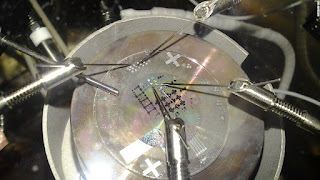Memristor
In recent year there has been a revolution in electronics, with a variety of phenomena being utilized in the construction of a new type of memory circuit for the computer application. A device which has had an increasing role is the memristor, whose description and properties have so far had little mention in physics education.
History
The memristor was the term coined in 1971 by Leon Chua as a missing non-linear passive two-terminal electrical component relating electric charge and magnetic flux linkage.
Leon Chua, a professor of electrical engineering at the University of California, Berkeley, predicted the existence of a fourth fundamental device, which he called a memristor. He proved that memristor behaviour could not be duplicated by any circuit built using only the other three elements, which is why the memristor is truly fundamental. Memristor is a contraction of ―memory resistor, because that is exactly its function: to remember its history.
Operation
The first, as the name memory resistor implies, is a type of non-volatile random access memory, or NVRAM. Such a memory would have very useful properties, in that it would not ‘forget’ the data it stores when the power is turned off. We think that NVRAM made with the type of memristor material that are currently being studied by many groups around the world could be a strong competitor to the flash memory market in about five years.
Benefits of memristor
- Provide greater resiliency and reliability when power is interrupted in data centres.
- Combines the job of working memory and hard drives into one tiny device.
- Have great data density
- Faster and less expensive the then MRAM.
- Uses less energy and produces less heat.
- Would allow for a quicker boot up since information is not lost when the device is turned off.
- Creating a computer that never has to boot up.
- Does not lose information when turned off.
Applications
- Non-volatile memory application.
- Low-power and remote sensing application.
- Crossbar latches as transistor replacements.
- Analogs computation and circuit applications.
- The circuit which mimics neuromorphic and biological systems(learning circuits).
- Programmable logic and signal processing.




Amazing topic, thanks for writing
ReplyDeleteThanks
DeleteThis word is use in our daily life but we r known about this word pls read this and comment for this word
ReplyDelete